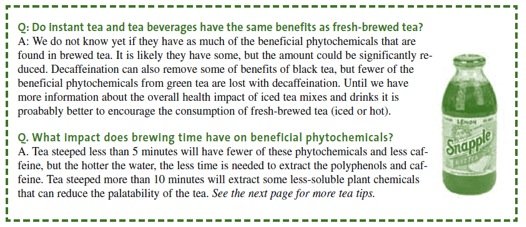An estimated 105 million American adults have total blood cholesterol values of 200 mg/dL and higher, a level at which cardiovascular disease risk rises significantly.1 Standard dietary approaches usually direct individuals to lower saturated fat intake and increase soluble fiber intake. Now it appears that the advice might also include, ?choose tea instead of coffee.?
A recent conference on the health effects of tea consumption was published in the Journal of Nutrition. One study reports the impact of drinking 5 cups of black tea a day for 3 weeks. This was done on blood lipids in 15 people with moderately elevated cholesterol levels. After three weeks, researchers noted two positive outcomes from drinking tea:1) LDL or ?bad cholesterol? decreased by 11.1 percent2) Lipoprotein (a), or Lp(a), decreased significantly (16.4 percent)Lp(a) appears to increase the risk of a fatal heart attack by blocking the breakup of blood clots. This finding is important because Lp(a) does not drop in response to taking powerful statin drugs despite their potent impact on LDL levels.Tea may lower serum cholesterol levels because it contains phytochemicals that block the absorption of cholesterol by the intestines.Interestingly enough, coffee contains two phytochemical compounds from the diterpene family (cafestol and kahweol) shown to increase LDL levels.2 Five cups of unfiltered coffee daily can raise serum cholesterol by 5 to 10 percent, so switching from 5 cups of coffee to 5 cups of tea daily might lower serum cholesterol levels at least 15-20 percent. Coffee also appears to contain another yet to be identified substance that raises homocysteine levels. Higher levels of serum homocysteine, like high LDL levels, have been linked to an increased risk of cardiovascular disease. Lowering homocysteine levels is likely to help reduce heart attacks and strokes.3 Switching from coffee to tea would likely lower homocysteine levels.Another study by researchers at Harvard and Bringham and Women?s Hospital has demonstrated that drinking 5-6 cups of tea per day (green or black and hot or cold) gave a significant boost to the immune system. Dr. Bukowski had volunteers who did not normally drink tea or coffee consume one or the other for a few weeks. He then compared subjects drinking coffee to those consuming tea and found the tea drinkers had a strengthened immune response. He showed blood from the tea drinkers was 5 times better able to react against bacteria by making interferon gamma, a molecule used to fight bacterial and viral infections as well as tumor cells.
Tea Is More HealthfulIn contrast to coffee, there is growing scientific evidence that regular consumption of tea may reduce the risk of both cardiovascular disease and perhaps also the overall risk for developing cancer.4, 5 A Welsh study of 3,454 older subjects found that those who consumed more tea were less likely to have more advanced atherosclerotic lesions in their aortas.6 A 5.6-year longitudinal analysis of data from the Rotterdam Study found a 70 percent lower risk of a fatal heart attack in those who consumed at least 2-3 cups of black tea daily compared to those who were not tea drinkers. The authors concluded, ?An increased intake of tea and flavonoids may contribute to the primary prevention of ischemic heart disease.?7The Bottom Line:Tea is the sixth leading beverage in the United States, trailing water, soda, coffee, milk and beer.8 Regular consumption of coffee appears to increase the risk of heart attacks and strokes. By contrast, drinking black or green tea instead of coffee is likely to reduce the risk of cardiovascular disease. It may also reduce the risk of at least some types of cancer and may improve the body?s first immune response to bacterial and viral invasions and so reduce the risk of a serious infection. For more on the health benefits of tea drinking, see the October 2003 supplement to the Journal of Nutrition.By James Kenney, PhD, RD, LD, FACNReferences:1. (NHANES III)2. Am J Clin Nutr 1995;61:1277-833. Nutr Rev 1999;57:299-3054. Am J Clin Nutr 2000; 71(suppl):1698S-702S5. Arch Intern Med 1999;159:2170-46. Am J Clin Nutr 1997;65:1489-947. Am J Clin Nutr 2002;75:880-68. www.teausa.com



